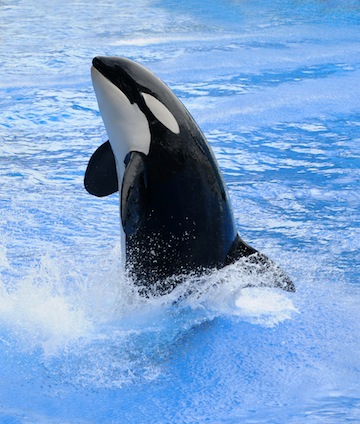Top Facts about Killer Whales
killer whale factsKiller whales, also known as Orcas (Orcinus orca) are fascinating creatures that attract a great deal of attention from marine biologists, as well as the general public.
Orcas are Apex predators and adults do not have any other threat in ocean than humans, Research is always being done about Killer Whales, and new facts about their habits, socialization, intelligence, and travel patterns are discovered continuosly.
Here are the top facts that make this cetacean so unique to the general public as well as to the scientists.
- Killer Whales are one of the fastest creatures in the sea, traveling up to 30 miles per hour.
- Killer Whales are able to control the flow of blood to their hearts and brains, which keeps them from suffering from a lack of oxygen when they are deep underwater.
- Killer Whales eat up to 5% of their body weight each day. This averages out to over 500 pounds of food for each Orca.
- Killer Whales do most of their socialization within their own pods. However, pods do socialize with other pods as well.
- When breeding, Killer Whales do not breed with relatives. They only breed with killer whales that are not closely related to them within their own pods.
- Killer Whales are called “Killer Whales” because they feed on other dolphins and smaller whales, not because they kill people. They are also know as orcas.
- The only recorded instances of a killer whale attacking a human being have been of attacks by Orcas held in captivity. No killer whale that lives in the wilds has ever attacked a human being.
- Killer Whales eat up to 5% of their body weight each day. This averages out to over 500 pounds of food”.
- Every Killer Whale has a mark behind it’s dorsal fin that is totally unique. These marks are used by humans to distinguish one killer whale from another, just as humans each have their own specific characteristics that make our appearances different from every one else’s.
- Killer Whales use vocalization to communicate with each other, but each pod has it’s own unique ‘accent,’ which makes it easy for Orcas to identify members of their own pods.
- Pods of killer whales are found in all oceans in the world, but the greatest numbers are found in cooler waters.
- Killer Whales are actually dolphins. In fact, they are the largest dolphins in existence, and can be up to 30 feet or more in length, and weigh up to 12,000 pounds.

- Killer Whale brain is five times larger than a humans. They are very social, intelligent, and curious. killer whales brains that have been studied with microscopes have proven to be as structured and developed as the human brain.
- Killer Whales have very organized and complex social structures, and divide themselves in pods, which operate as human families do. They protect their young, ill, and injured within their pods.
- Killer Whales spend 60% of their time foraging for food. killer whales do not migrate, but they have been known to travel hundreds of miles to find fresh food that is in ‘season.’
- Life expectancy of a Killer Whale in the wild is 50 – 60 years for males, and up to 90 years for females, however, Killer Whales held in captivity have not lived longer than 30 years, and the average life expectancy for captive Orcas is only 20 years.
- Female Killer whales usually do not breed until they are between the ages of 12 and 16 years old. Their gestation period is 15 – 17 months, as opposed to 9 months for humans. They nurse their calves for up to 2 years. On an average, each female Orca that lives in the wilds will have approximately five calves during her lifetime.

